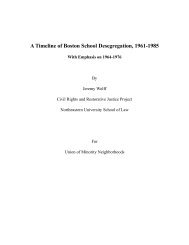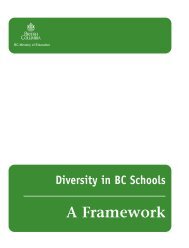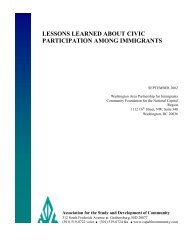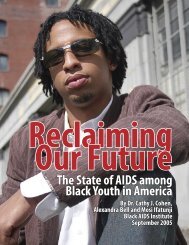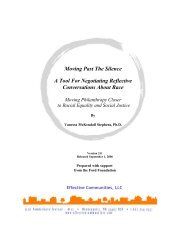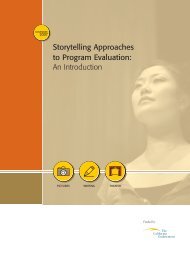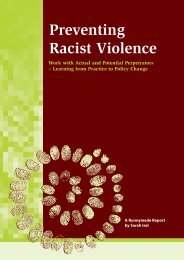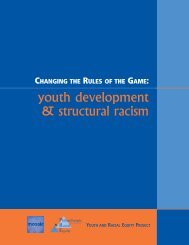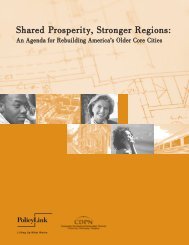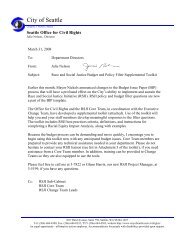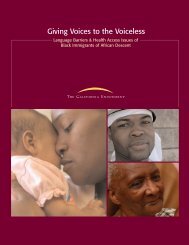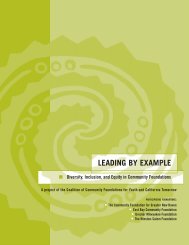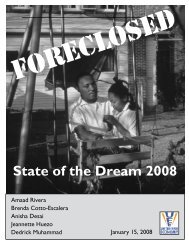Stories of Philanthropic Leadership in Advancing Regional and ...
Stories of Philanthropic Leadership in Advancing Regional and ...
Stories of Philanthropic Leadership in Advancing Regional and ...
You also want an ePaper? Increase the reach of your titles
YUMPU automatically turns print PDFs into web optimized ePapers that Google loves.
REGIONAL OPPORTUNITYsystem than suburban riders, <strong>in</strong> effect subsidiz<strong>in</strong>gsuburban transit;• Regressive pric<strong>in</strong>g structures—Many transitagencies <strong>of</strong>fer discounts for bulk purchases <strong>in</strong> theform <strong>of</strong> cost sav<strong>in</strong>gs for customers that buymonthly or annual passes or books that conta<strong>in</strong>multiple tickets. But these discounts are<strong>in</strong>equitable because they favor those who canafford the more expensive, one-time expenditure,<strong>and</strong> result <strong>in</strong> greater out-<strong>of</strong>-pocket transit costsfor low-<strong>in</strong>come people;• Decisionmak<strong>in</strong>g—Often, low-<strong>in</strong>come <strong>and</strong> people<strong>of</strong> color <strong>in</strong> urban communities do not haveconsistent <strong>and</strong> mean<strong>in</strong>gful opportunities to<strong>in</strong>fluence a region’s transit decisions; <strong>and</strong>• Fare <strong>in</strong>creases—Many city residents do not own acar, some <strong>of</strong> out <strong>of</strong> choice, others because theycannot afford car ownership’s many expenses(purchase, ma<strong>in</strong>tenance, repair, <strong>in</strong>surance, gas,<strong>and</strong> park<strong>in</strong>g). For these <strong>in</strong>dividuals, public transitis an <strong>in</strong>tegral part <strong>of</strong> daily life <strong>and</strong> for low-<strong>in</strong>cometransit riders, form a significant part <strong>of</strong> theirmonthly budget.A focus on equity <strong>in</strong> the region was not a driv<strong>in</strong>gforce for the grant decision or an impact concern forthe coalitions’ funders <strong>in</strong> any <strong>of</strong> the abovementionedcities. Yet most major metropolitanurban public transit systems connect communitiessignificantly beyond the urban center. If atransportation situation impacts the accessibility <strong>of</strong>low-<strong>in</strong>come transit riders, it can catapult the localequity issue <strong>in</strong>to a regional struggle.ResultsAccord<strong>in</strong>g to Greenwood, the Sloan Foundationhopes that the Straphangers work will be replicated<strong>in</strong> other places. This goal has already been met <strong>in</strong>several other municipalities, some where theFoundation specifically encouraged its replicationthrough grantmak<strong>in</strong>g (e.g., Chicago, Philadelphia),<strong>and</strong> some where groups saw a potential local value<strong>in</strong> Straphangers’ work (e.g., Los Angeles, Toronto).The Foundation also anticipates that theStraphangers will be able to build on its exist<strong>in</strong>gtrack record <strong>and</strong> by so do<strong>in</strong>g have a clear impact onthe quality <strong>of</strong> the New York City Transit System.F<strong>in</strong>ally, the Foundation believes that Straphangersshould <strong>in</strong>stitutionalize their work so that theorganization can susta<strong>in</strong> its efforts absent theFoundation’s support.The CCHD’s respective grants to the Boston <strong>and</strong>Baltimore coalitions are <strong>in</strong> their first year <strong>of</strong> a threeyeargrant cycle, so results are fairly prelim<strong>in</strong>ary. Eachgroup has seen <strong>in</strong>itial successes <strong>in</strong> empower<strong>in</strong>g transitriders to engage their region’s transit policymakers<strong>and</strong> build a more <strong>in</strong>clusive decisionmak<strong>in</strong>g structure.Additionally, each coalition has developed <strong>and</strong> begunto advance specific policy proposals <strong>and</strong> has hadsuccess <strong>in</strong> m<strong>in</strong>imiz<strong>in</strong>g the impact or extent <strong>of</strong> aproposed fair <strong>in</strong>crease.Lessons LearnedAccord<strong>in</strong>g to the Sloan Foundation, the capacity toanalyze data <strong>and</strong> use it to <strong>in</strong>form policy <strong>and</strong>advocacy is a key to success for transportationadvocates. But these skills are not yet widespread.Additionally, data collect<strong>in</strong>g <strong>and</strong> analysis from bothtransit agencies <strong>and</strong>transit riders is notwidely available.Demonstrat<strong>in</strong>g If a transportation situationmeasurable results,impacts the accessibility <strong>of</strong>evaluat<strong>in</strong>g policylow-<strong>in</strong>come transit riders, itimpacts,formulat<strong>in</strong>g can catapult the local equityalternativeissue <strong>in</strong>to a regional struggle.methodologies <strong>and</strong>options, <strong>and</strong>survey<strong>in</strong>gstakeholders gives advocates the tools to effectivelyparticipate <strong>in</strong> policymak<strong>in</strong>g <strong>and</strong> articulate theirconstituents’ needs <strong>and</strong> dem<strong>and</strong>s.Field representatives from CCHD state that their mostimportant lesson is that community organiz<strong>in</strong>g has apersistent, proven ability to <strong>in</strong>fluence public policydecisions. It is the relationship-build<strong>in</strong>g aspect amongdifferent community organizations <strong>and</strong> constituentsthat demonstrates the potential <strong>of</strong> communityorganiz<strong>in</strong>g. Currently, CCHD is revis<strong>in</strong>g its grantapplication format <strong>and</strong> its grant report<strong>in</strong>g requirements<strong>in</strong> order to collect more <strong>in</strong>formation from applicants orgrantees so as to better evaluate the impact <strong>of</strong> theirfund<strong>in</strong>g <strong>and</strong> monitor the field, ultimately provid<strong>in</strong>g amethod to share the progress <strong>and</strong> growth <strong>of</strong> theirgrantees through the fund<strong>in</strong>g cycles.Though at different stages <strong>of</strong> their growth <strong>and</strong> withdifferent funders, all three community-based coalitionspursued varied strategies <strong>in</strong> order to develop theiradvocacy capacity, elim<strong>in</strong>ate transit access barriers, <strong>and</strong>ensure that transit policy decisions do not perpetuate99Funders’ Network for Smart Growth <strong>and</strong> Livable Communities



